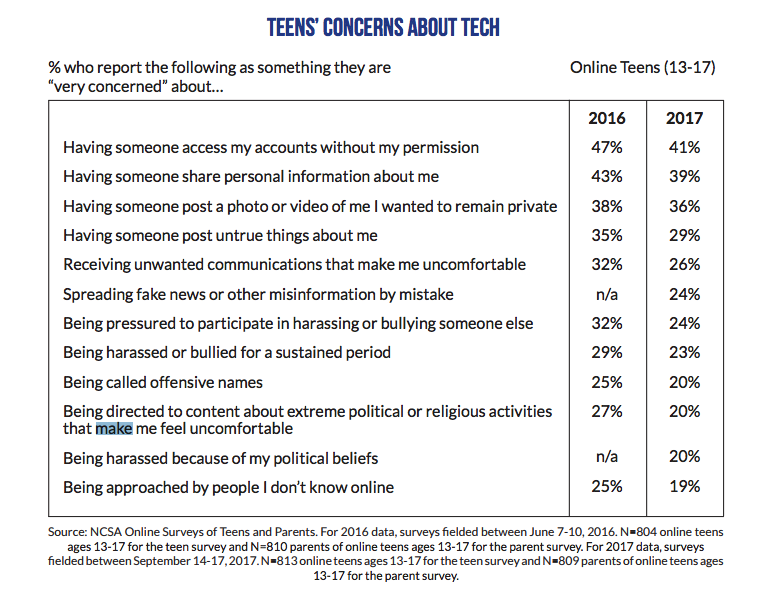
 Listen to Larry Magid’s one-minute CBS News Radio segment about these new surveys:
Listen to Larry Magid’s one-minute CBS News Radio segment about these new surveys:
blank
Two separate studies released on Thursday show interesting data about how both young children and teens and their parents are using and thinking about media. The one aimed at younger children found a spike in mobile use in the home, while the one aimed at teens found that “Smartphones are now ubiquitous in teens’ lives, but constant mobile connectivity comes with a cost.”
Young children study
The Common Sense Census: Media Use by Kids Age Zero to Eight, which interviewed 1,454 parents of kids in that age group, found that a “spike in the number of young children who have their own tablet device (now 42 percent, up from 1 percent in 2011). The survey also found that children age 0 to 8 are spending an average of 8 minutes a day on their mobile devices, up from 5 minutes in 2011. It’s important to note that the iPad wasn’t even released until 2010 and that smartphone penetration has sky rocketed since that earlier study.
The study found that children age 8 and under spend an average of 2 hours and 19 minutes a day with screen media, which is about the same as in prior years.
TV remains the main source at 58 minutes a day, but mobile has risen to 48 minutes a day from 5 minutes in 2011 and 15 minutes in 2013.
The survey also found that:
- Ninety-five percent of families with children age 0 to 8 now have a smartphone (up from 63 percent in 2013 and 41 percent in 2011), and 78 percent have a tablet (up from 40 percent in 2013 and 8 percent just six years ago, in 2011).
- Families with young children are now more likely to have a subscription video service such as Netflix or Hulu (72 percent) than they are to have cable TV (65 percent).
- According to parents, nearly half (49 percent) of children age 8 or under often or sometimes watch TV or videos or play video games in the hour before bedtime, contrary to recommendations from pediatricians.
- About one in 10 kids age 8 or under has a “smart” toy that connects to the internet (10 percent) or a voice-activated virtual assistant device available to them in the home, such as an Amazon Echo or Google Home (9 percent).
- Sixty-one percent of lower income families now have a tablet device, compared to 85 percent of higher-income families.However, the gap in overall mobile ownership has virtually disappeared (3 percentage points), due to the number of lower-income families that now have a smartphone. In 2011, 34 percent of lower-income families had a mobile device in the home; today 96 percent do.
- Children from lower income households spend an average of 1 hour 3 minutes more screen time than those from higher income homes (3:29 vs. 1;50)
- Hispanic/Latino parents express the highest levels of concern about potentially negative issues, such as sex and violence with 54 percent of Hispanic/Latino parents saying they’re “very” concerned about violence in media, compared to 38 percent of African-American parents and 28 percent of whites.
Nearly half (49%) of children under 8 “often or sometimes” watch TV or videos or play video games in the hour before bedtime, which is contrary to the recommendation of the American Academy of Pediatricians, which recommends that children refrain from screen time an hour before bedtime and don’t “sleep with their devices.”
Teen study
Keeping Up with Generation App: NCSA Parent/Teen Online Safety Survey, conducted by the National Cyber Security Alliance found that 82% of teens own a smartphone, 67% have a laptop and 48% have a tablet. Nevertheless “constant mobile connectivity comes with a cost. First there is the issue of “fake news:”
- Almost 50 percent of teens said they were “very” or “somewhat” concerned about mistakenly spreading fake news or misinformation over the internet.
- Parents were even more concerned about the issue, with over 60 percent of them indicating they were “very” or “somewhat” concerned that their teen would spread misinformation ‒ a key indicator of how prevalent the issue of fake news has become over the last year.
- Twenty percent of parents also said they’d like to learn how to identify fake news, and 30 percent of teens said they’d like to know more about this kind of information.
But there are other issues as well
- Close to a third of teens (28%) say they spend “too much time” online
- Almost half (46%) say they spend “a little more time” online than they would like.
- Parents were also concerned about their own screen time, with 22 percent saying they spend “too much time” online
- Almost 60 percent saying they spend “a little more time” online than they would like.
The study reported that “screen time is the most frequent point of technology-related tension between teens and their parents, according to both parties.”
- Twenty-two percent of teens say they frequently have disagreements with their parents about screen time and 26 percent of parents say they argue with their children about it. Boys are more likely than girls to report frequent disagreements over screen time (25% vs. 18%).
Anyone who thinks that teens don’t listen to their parents should consider that nearly half (47%) of online teens say their parents are among their top three sources for learning how to stay safe online, compared with 40 percent who say their friends are top sources. Another one in three (32%) of online teens say the news media is a primary source for education about online safety and security.
